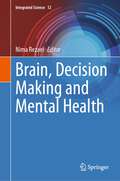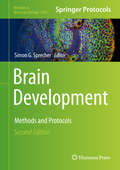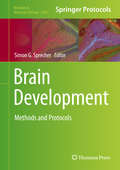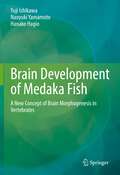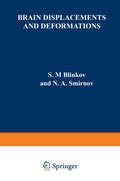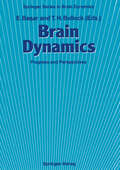- Table View
- List View
Brain-Computer Interfaces: Principles and Practice
by Jonathan Wolpaw Elizabeth Winter WolpawA recognizable surge in the field of Brain Computer Interface (BCI) research and development has emerged in the past two decades. This book is intended to provide an introduction to and summary of essentially all major aspects of BCI research and development. Its goal is to be a comprehensive, balanced, and coordinated presentation of the field's key principles, current practice, and future prospects.
Brain Control: Developments in Therapy and Implications for Society
by D. LindenInterest in techniques to control the brain and thereby improve its function has surged, yet how realistic are these expectations and what are the ethical implications? This book reviews the main techniques of controlling brain processes for medical purposes, situating them within ethical and legal debates on autonomy and fairness.
Brain Control of Wakefulness and Sleep
by Mircea M. Steriade Robert W. McCarleyBrain Control of Wakefulness and Sleeping explores the history of efforts to understand the nature of waking and sleeping states from a biological point of view. This research represents the synthesis of the work of two individuals who have devoted their careers to investigating the mysterious states of the mind. This landmark book will interest the beginner scientist/researcher as well as the sleep clinician, with chapters on subjects including Neuronal Control of REM Sleep, Motor Systems and the Role of Active Forebrain, and Humoral Systems in Sleep Control. The authors explore the behavioral and physiological events of waking and sleep, analyzing the current realities and the future possibilities of unifying basic studies on anatomy and cellular psychology.
Brain Crosstalk in Puberty and Adolescence (Research and Perspectives in Endocrine Interactions #13)
by Jean-Pierre Bourguignon Jean-Claude Carel Yves ChristenThis volume provides the reader with a pathophysiological perspective on the role of CNS in puberty and adolescence, starting from genetic/molecular aspects, going through structural/imaging changes and leading to physical/behavioral characteristics. Therefore, renowned investigators involved in both animal and human research shared recent data as well as overall appraisal of relevant questions around CNS control of puberty and adolescence. No doubt that this volume will inspire those involved in either scientific research or clinical practice or both in the fascinating field of puberty and adolescence.
Brain CT Scans in Clinical Practice (In Clinical Practice)
by Usiakimi IgbaseimokumoThis updated second edition provides a concise and up-to-date guide to emergency brain CT scans. Revised illustrations and images are included to assist readers in understanding key concepts in a clear way. The use of brain CT scans by health care professionals is increasingly common and has been effective in the minimising of costs and the unnecessary transfer of traumatic brain injury patients. The book aims to give nurses, emergency room physicians, primary care physicians, and doctors the information and tools needed to examine CT scans and explain them to their patients. With this knowledge emergency physicians and trauma surgeons will be able to decide whether an injury is life threatening.
Brain CT Scans in Clinical Practice (In Clinical Practice Ser.)
by Usiakimi IgbaseimokumoAcross emergency rooms all over the world, thousands of patients are referred for brain CT scans daily. A radiologist often has to interpret the scan or a consultation has to be made to a neuros- geon to review the scan. Most of this happens late at night and is a signi?cant source of discontent. Thus having frontline phy- cians to be pro?cient in interpreting the emergency brain CT scan improves the ef?ciency of the whole pathway of care and is pot- tially life saving as time is of the essence for many patients with severe brain injury or stroke. Underlying all of the above and the primary reason for writing this book is because the skill required to determine an immediate life threatening abnormality in a brain CT scan is so basic and can be learned in a short time by people of various backgrounds and certainly by all physicians. ‘Indeed the emergency head CT scan is comparable to an electrocardiogram in usefulness and most de?nitely as easy to learn. ’ This book is therefore written for ca- givers the world over to demystify the emergency CT brain scan and to empower them to serve their patients better. It is obvious to me from the response from people I have had opportunity to teach this subject that not only is there a desire to learn this basic skill but also people learn it quickly and wonder why it has not been presented so simply before.
Brain Damage and Repair: From Molecular Research to Clinical Therapy
by T. Herdegen J. Delgado-GarciaThis book builds a novel bridge from molecular research to clinical therapy. This approach reveals the functional features of neurons and glia in the particular context of vulnerability and self-protection, intracellular properties and extracellular matrix. Arising from this platform, this volume unfolds the molecular and systemic processes underlying migration disorders, axonal injury, repair and regeneration.
The Brain-Dead Organ Donor: Pathophysiology and Management
by Dimitri Novitzky and David K C CooperAddressing all aspects of brain death and thoroughly detailing how a potential organ donor should be maintained to ensure maximum use of the organs and cells, The Brain-Dead Organ Donor: Pathophysiology and Management is a landmark addition to the literature. This first-of-its-kind, multidisciplinary volume will be of interest to a large section of the medical community. The first section of the book reviews the historical, medical, legal, and ethical aspects of brain death. That is followed by two chapters on the pathophysiology of brain death as investigated in small and large animal models. This includes a review of the many hormonal changes, including the neuroendocrine- adrenergic ‘storm’, that takes place during and following the induction of brain death, and how they impact metabolism. The next section of the book reviews various effects of brain death, namely its impact on thyroid function, the inflammatory response that develops, and those relating to innate immunity. The chapters relating to assessment and management of potential organ donors will be of interest to a very large group of transplant surgeons and physicians as well as critical care and neurocritical care physicians and nurses. Neurologists, endocrinologists, neurosurgeons, and pathologists will also be interested, especially in the more basic science sections on various aspects of brain-death and hormonal therapy. Organ procurement organizations and transplant coordinators worldwide will also be interested in this title. Other chapters will be of interest to medical historians, medico-legal experts, and ethicists.
Brain Death: A Reappraisal
by C. MachadoThis text provides an overview of the processes of brain death, exploring the concepts and historical approach of human death, clinical examinations of brain-dead patients, ancillary tests in coma and brain death, bioethical discussions of brain death and its relationship with some consciousness disturbances, and the legal considerations of human death. Unlike other, narrow-focus reference this book encompasses a wide spectrum of issues including medical, legal, bioethical and historical aspects.
Brain Death and Disorders of Consciousness (Advances in Experimental Medicine and Biology #550)
by D. AlanShewmon CalixtoMachadoAlthough some decades have passed, there are still worldwide controversies about a concept of human death on neurological grounds. There are also disagreements on the diagnostic criteria for brain death, whether clinical alone or clinical plus ancillary tests. Moreover, some scholars who were strong defenders of a brain-based standard of death are now favoring a circulatory-respiratory standard. The study of coma is extremely important because lesions of the brain are responsible for quality of life in patients or cause of death. The main goal of Brain Death and Disorders of Consciousness is to provide a suitable scientific platform to discuss all topics related to human death and coma.
Brain, Decision Making and Mental Health (Integrated Science #12)
by Nima RezaeiBrain, Decision Making, and Mental Health acknowledges that thinking is not a constant phenomenon but varies considerably across cultures. Critical thinking is particularly important in bridging thinking divisions and its applicability across sciences, particularly medical sciences. We see critical thinking as educable and the arts as means to achieve this purpose. We address the multidimensional relationship between thinking and health and related mechanisms. Thinking mainly affects emotion regulation and executive function; in other words, both mental and physical health are related as a function of thoughts. Considering the thinking‐feeling‐emotion regulation/executive function pathway, it would be reasonable to propose thinking capacities‐based interventions to impact emotion regulation and executive function, such as mindfulness and psychotherapy. We review decision-making taking place in integrated and social contexts and discuss the decision-making styles-decision outcomes relation. Finally, artificial thinking and intelligence prepare us for decision-making outside the human mind.
Brain Degeneration and Dementia in Sub-Saharan Africa
by Seggane Musisi Stanley JacobsonStemming from a 2012 conference entitled Brain Degenerations and Emerging Mental Health Challenges in Sub-Saharan Africa, this book is aimed at both the general practitioner interested in CNS disorders, and the specialist who would like to know more about CNS pathology in Africa. By employing a broad defi nition of what brain degeneration means, the authors are able to touch upon everything from dementias and CNS malignancy to traumatic brain injury and CNS infective processes.This book draws from and builds upon the original conference presentations, and incorporates the most up-to-date science behind brain degeneration as well as actual case reports. Each of the book’s six sections off er the reader a deeper understanding of brain degeneration as it exists in Sub-Saharan Africa.
Brain-Derived Neurotrophic Factor (Neuromethods #143)
by Carlos B. Duarte Enrico TongiorgiThis volume discusses the latest techniques and methodologies used in the neurotrophin field to study the physiology of the Brain-Derived Neurotrophic Factor (BDNF). The book provides the tools essential to any researcher that intends to explore the peculiar regulation of this neurotrophin from gene expression to its release and the signaling by TrkB receptors, as well as to study the neuronal responses to BDNF or the role of neurotrophin in various neurological diseases. In Neuromethods series style, chapters include the kind of detail and key advice from the specialists needed to get successful results in your laboratory.Cutting edge and comprehensive, Brain-Derived Neurotrophic Factor(BDNF) is a valuable resource for researchers who want to further study the diversity of physiological roles of this important growth factor.
Brain Development: Normal Processes and the Effects of Alcohol and Nicotine
by Michael W. MillerThis is the first book about both normal development of the nervous system and how early exposure to alcohol and nicotine interferes with this development. The developing nervous system is highly dynamic and vulnerable to genetic and epigenetic factors that can be additive or synergistic. Disruption of normal brain development leads to an array of developmental disorders. One of the most common of these is mental retardation, the prime cause of which is prenatal exposure to alcohol. As chapters in this book show, alcohol has direct effects on the developing neural system and it affects genetic regulation. Another common neurotoxin is nicotine, and it is discussed in this book for three reasons: (1) the number of adolescents who smoke cigarettes is rising in some populations; (2) prenatal exposure to nicotine affects neurotransmitter systems that are critical for normal brain development and cognition; and (3) prenatal exposure to nicotine is often accompanied by prenatal exposure to alcohol.LThe mature brain is the culmination of an orderly sequence of the basic ontogenetic processes--cell proliferation, migration, differentiation, and death. Neural stem cells and progenitors proliferate in discrete sites; then, young neurons migrate long distances to their residences where they form neural networks. During this sequence many immature cells die, presumably eliminating unsuitable or non-competitive cells. Each process is regulated by genetic and environmental factors. When this regulation goes awry, a dysmorphic and dysfunctional brain results. Though this can be tragic in clinical settings, in experimental contexts it provides keen insight into normal brain development.LThe book is divided into three parts. The first describes neural ontogeny in the normal brain. The second and third deal with the consequences of early exposure to alcohol and nicotine. Though there are similarities in the effects of these two toxins, there are also intriguing differences. The commonalities reflect the plasticity and resilience of the developing brain while the differences point to the targeted effects of the two toxins. Exploring these effects brings a richer appreciation of brain development. The book will be of interest to neuroscientists, developmental biologists, teratologists, pharmacologists, toxicologists, neurologists, neuropsychologists, and to their students and trainees.
Brain Development: Methods and Protocols (Methods in Molecular Biology #2047)
by Simon G. SprecherThis book provides a thorough introduction to widely used techniques for the study of the intersection between developmental biology and neuroscience, an exceptional area to address and investigate impacting biological questions. The fully updated volume examines cutting-edge techniques on a representative range of animals, including widely used genetic model systems, such as the fruit fly, zebra fish, chicken, and mouse, as well as non-canonical experimental systems opened up through the advent of genome editing. Written for the highly successful Methods in Molecular Biology series, chapters include introductions to their respective topics, lists of the necessary materials and reagents, step-by-step, readily reproducible laboratory protocols, and tips on troubleshooting and avoiding known pitfalls. Authoritative and up-to-date, Brain Development: Methods and Protocols, Second Edition is an ideal guide for researchers interested in utilizing recent technical advances in molecular genetics for the study of the brain.
Brain Development: Methods and Protocols (Methods in Molecular Biology #1082)
by Simon G SprecherProviding widely used techniques in genetic model systems and many complementing animal models, Brain Development: Methods and Protocols focuses its expert contributions on two key technical aspects of developmental neurobiology: detection of gene expression and functional characterization of developmental control genes. Covering animal models such as the fruit fly, zebra fish, chicken, and mouse, this detailed book views in situ hybridization, reporter gene expression, and immunohistochemical staining methods, as well as RNA interference, Morpholino, or transgenic techniques through the prism of these models. Written in the highly successful Methods in Molecular Biology series format, chapter include introductions to their respective topics, lists of the necessary materials and reagents, step-by-step, readily reproducible laboratory protocols, and tips on troubleshooting and avoiding known pitfalls. Practical and cutting-edge, Brain Development: Methods and Protocols aims to provide precise technical protocols but also allows for comparing a wide range of protocols in different tissues and species.
Brain Development in Drosophila melanogaster (Advances in Experimental Medicine and Biology #628)
by Gerhard Martin TechnauBrain Development of Medaka Fish: A New Concept of Brain Morphogenesis in Vertebrates
by Yuji Ishikawa Naoyuki Yamamoto Hanako HagioThis book describes the developmental process of the brain of the medaka fish. It aims to understand the brain structure of vertebrates, including humans, by taking the brain of the medaka fish as an example and showing its actual developmental process. From developmental and evolutionary viewpoints, the understanding of the brain proceeds from simple to complex structures. Fish retain the basic form of vertebrates, and their brain morphology is relatively simple. Therefore, the fish brain is useful in understanding the brain structure. This book is unique for describing the entire process of the brain development in a specific fish. In addition, the book introduces the readers to a new concept of “Hourglass of Brain Morphogenesis”, concerning the general rule of brain morphogenesis in vertebrates. The authors propose that the brain morphology is highly conserved at the middle developmental stage but diverges more extensively at earlier and later stages. The new concept challenges the accepted theory that has been widely shared for about 200 years since K. von Baer (1828, 1837) and K. von Kupffer (1906) who proposed that three primary brain vesicles at earlier developmental stages develop into five secondary brain vesicles at later developmental stages in all vertebrates. The book provides a basic understanding of the vertebrate brain and is useful for all readers who wish to understand the complex structure of the brain.
Brain Displacements and Deformations
by S. M. BlinkovIn writing our book we had in mind both practicing physicians and scientif ic personnel. We hope that the former will benefit from an analysis of clinical symptoms and changes in the morphological substrate which produce them, and that the latter will be interested in facts illustrating the resistance of nervous tissue to compression and displacement, and in our concept of the primary role played by blood supply in the functional disturbances of a deformed brain stem. Although only a short time has elapsed since the first edition of the book, it has been necessary to introduce a number of addenda and corrections into the present edition. The chapter "Roentgenological Manifestations of Brain Displacements," written by N. S. Plevako and Z. N. Polyanker, has also been expanded. We are glad that a competent publishing house such as Plenum Press has undertaken the American publication of the book; we offer our sincere thanks to Mr. George Onischenko for his excellent translation; and we express our gratitude to Mezhdunarodnaya Kniga, the Soviet Book Export Agency, in the person of Galina Aleksandrovna Khudozhnikova, for their cooperation.
Brain Dopaminergic Systems: Imaging with Positron Tomography (Developments in Nuclear Medicine #20)
by B. Mazoyer J. L. Martinot L. Farde D. Comar J. C. BaronBrain Dynamics: Progress and Perspectives (Springer Series in Brain Dynamics #2)
by Erol Ba 351 Ar Theodore H. BullockThis volume is based on contributions to the second Brain Dynamics Conference, held in Berlin on August 10-14, 1987, as a satellite conference of the Budapest Congress of the International Brain Research Organization. Like the volume resulting from the first conference, Dynamics of Sensory and Cognitive Processing by the Brain, the present work covers new approaches to brain function, with emphasis on electromagnetic fields, EEG, event-related potentials, connectivistic views, and neural networks. Close attention is also paid to research in the emerging field of deterministic chaos and strange attractors. The diversity of this collection of papers reflects a multipronged advance in a hitherto relatively neglected domain, i. e., the study of signs of dynamic processes in organized neural tissue in order both to explain them and to exploit them for clues to system function. The need is greater than ever for new windows. This volume reflects a historical moment, the moment when a relatively neglected field of basic research into available signs of dynamic processes ongoing in organized neural tissue is expanding almost explosively to complement other approaches. From the topics treated, this book should appeal, as did its predecessor, to neuroscientists, neurologists, scientists studying complex systems, artificial intelligence, and neural networks, psychobiologists, and all basic and clinical investigators concerned with new techniques of monitoring and analyzing the brain's electromagnetic activity.
Brain Dynamics: Synchronization and Activity Patterns in Pulse-Coupled Neural Nets with Delays and Noise (Springer Series in Synergetics)
by Hermann HakenThis book addresses a large variety of models in mathematical and computational neuroscience. It is written for the experts as well as for graduate students wishing to enter this fascinating field of research. The author studies the behaviour of large neural networks composed of many neurons coupled by spike trains. An analysis of phase locking via sinusoidal couplings leading to various kinds of movement coordination is included.
Brain Dynamics: An Introduction to Models and Simulations (Springer Series in Synergetics)
by Hermann HakenThis is an excellent introduction for graduate students and nonspecialists to the field of mathematical and computational neurosciences. The book approaches the subject via pulsed-coupled neural networks, which have at their core the lighthouse and integrate-and-fire models. These allow for highly flexible modeling of realistic synaptic activity, synchronization and spatio-temporal pattern formation. The more advanced pulse-averaged equations are discussed.
Brain Edema: From Molecular Mechanisms to Clinical Practice
by Jérôme Badaut Nikolaus PlesnilaBrain Edema: From Molecular Mechanisms to Clinical Practice brings together the most widely recognized experts in experimental and clinical brain edema research to review the current knowledge gathered on the molecular and cellular pathophysiology and clinical management of brain edema. This timely book also discusses future directions of research and treatment. Brain edema is an integral and acutely life-threatening part of the pathophysiology of multiple cerebral and non-cerebral disorders, including traumatic brain injury, cerebral ischemia, brain tumors, cardiac arrest, altitude sickness and liver failure. Affecting millions worldwide, research over the past few years has shown that a plethora of complex molecular and cellular mechanisms contribute to this pathological accumulation of water in the brain parenchyma. In parallel, the development of new neuroimaging tools has provided a new way to examine how edema develops longitudinally and in real time, both in pre-clinical models and in patients. Despite intense research over the past few decades, therapeutic options are still limited and sometimes not effective. - Presents a comprehensive understanding of the molecular mechanisms involved in edema formation and resolution - Discusses the specific role of edema development in several pathologies, including traumatic brain injury, stroke, brain tumors, cardiac arrest, and liver failure - Proposes a new classification of edema based on molecular processes - Discusses clinical management of new clinical trials coming from pre-clinical studies - Addresses the possible link between edema formation, other molecular and cellular processes, including inflammation and neuroinflammation
Brain Edema: Proceedings of the Symposium September 11–13, 1965, Vienna
by Igor Klatzo Franz SeitelbergerThe Symposium on Brain Edema has been organized by the Osterreichische Arbeitsgemeinschaft fur Neuropathologie and by the Problem Commission for Neuropathology of the World Federa tion of Neurology. We would like to express our thanks to Dr. L. van Bogaert, president of the W.F.N., for his great interest in the design of this conference and for his energetic support. One of the aims ofthe Problem Commission for Neuropathology has been to contribute to the advances in various problems which are becoming ripe for elucidation by experts in different fields. The idea of the Symposium on Brain Edema has as its background a compelling necessity to elucidate this subject which is clinically so important and neuropathologic ally so poorly understood. It was hoped that this could be achieved by a multidisciplinary approach involving a variety of aspects to be discussed and correlated. Brain edema, being an abnormal cerebral condition, belongs basically to the sphere of neuropathology, but to be successful in our endeavors we had to apply neuropathology in its most modern and widest terms. By this we understand that such neuropathology includes the study of all abnormal phenomena in the nervous tissue related to the structural alterations, and by "structural" we mean not only tissual or cellular ones but also changes on ultrastructural and molecular levels. Thus we needed close and integrated coopera tion of experts in fields such as neurohistology, histochemistry, electron microscopy, neurochemistry, and neurophysiology.










